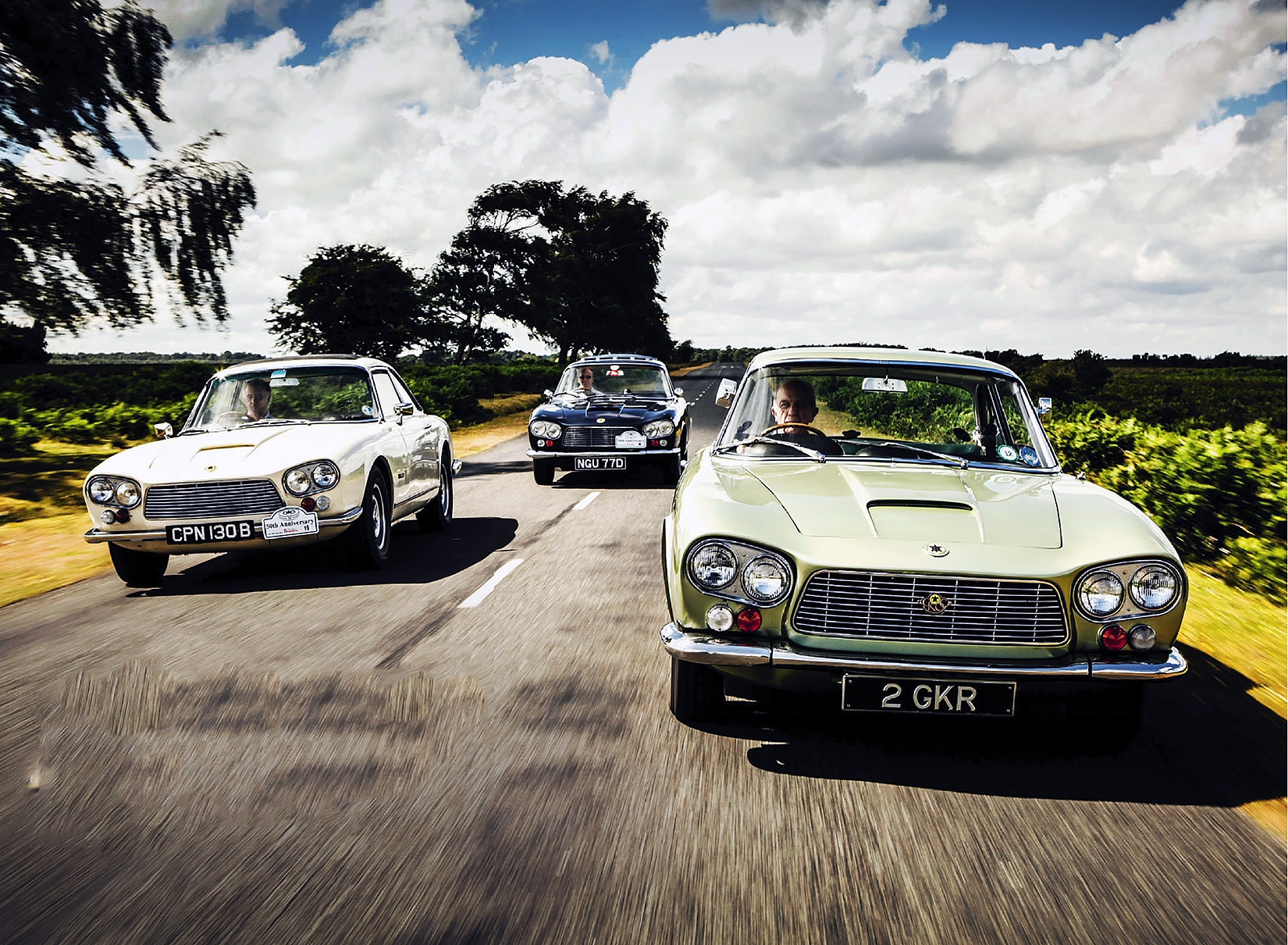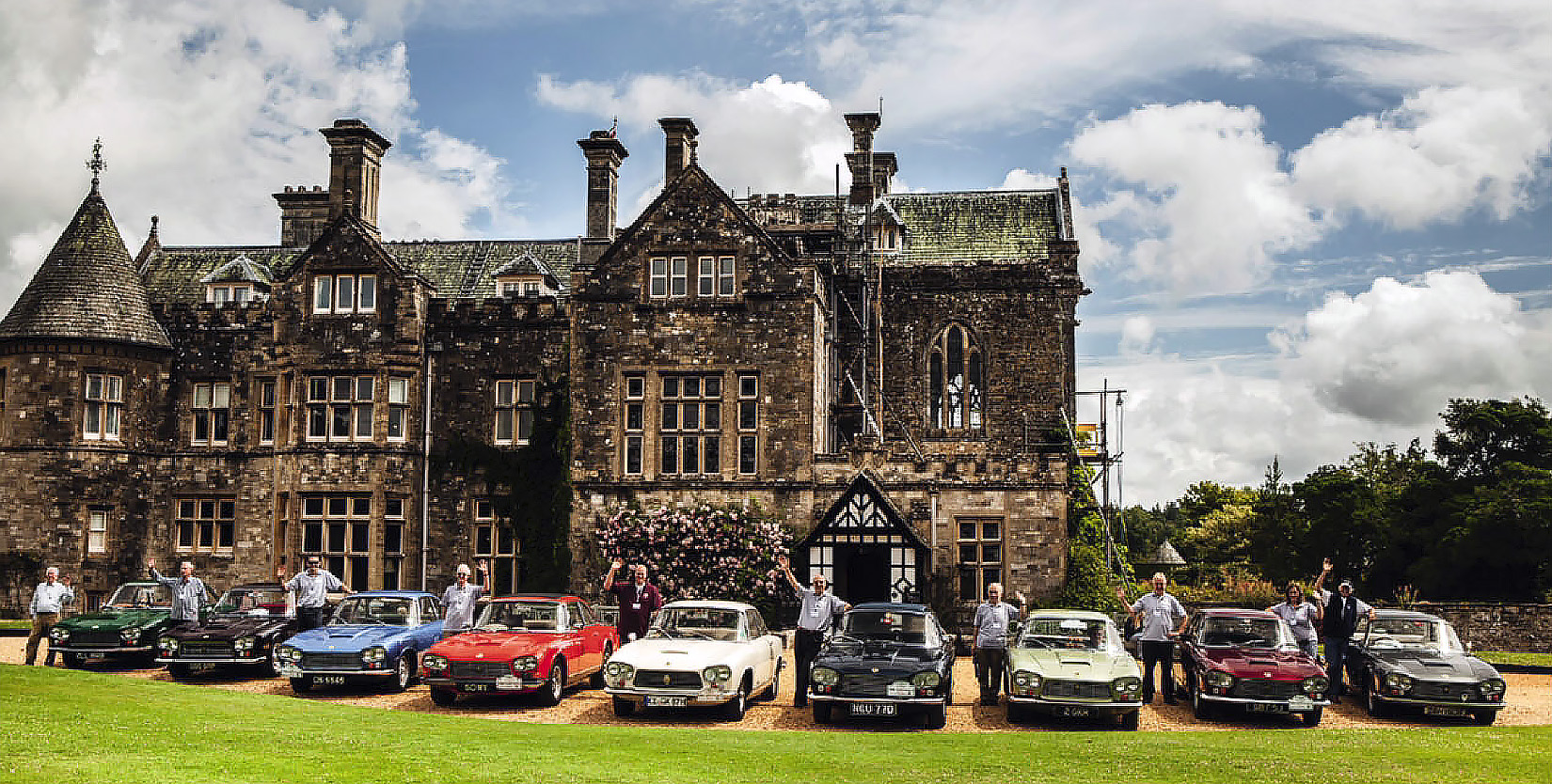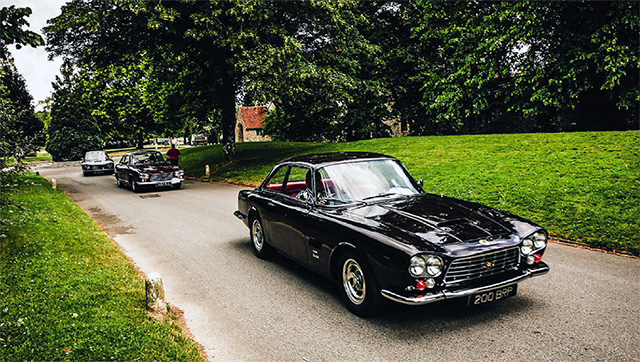
The Eastleigh express. David Evans meets the people who made the Gordon-Keebles, and the cars’ devoted owners, as they toast the sublime GT’s 50th anniversary. Photography Tony Baker.
If you’re not careful, you can become obsessed with the Gordon-Keeble. For me, it begins on a family holiday somewhere in mid-Wales about 40 years ago. There’s a familiar shape in front – familiar, that is, only from the much-thumbed page of my 1965 Observer’s Book of Automobiles. “It’s a Gordon-Keeble!” So Dad puts his foot down sufficiently for me to briefly confirm that it is, indeed, one of the famous, tortoise-badged four-seaters. Then it’s gone.
Spool forward to the present and the sight of three filling the rear-view mirror of snapper Baker’s Passat estate, with a picture-postcard backdrop, is almost too much to take. That exquisite styling by a 21-year-old Giorgetto Giugiaro is, to my mind, his finest hour, like an Alfa GTV only bigger and better proportioned.

“You’ll be going back in one of the Keebles, I expect,” says Baker, once we’ve done the photos. “And don’t forget we need a shot of you driving.” As if that could slip my mind. When we turn into the Beaulieu grounds, former GKOC chairman Mike Webster generously volunteers his keys.
The clutch, gearchange and steering are all weighty, but, as Webster puts it: “You only need second and fourth.” He spots a smile and adds: “It’s addictive, isn’t it?” as I give 96 – each car is known by its chassis number in the club – a gentle burst of enthusiasm past the duck pond and once more round the block.

It’s the perfect end to a day that starts in surreal fashion on the top floor of the short-stay car park at Southampton Airport, Eastleigh, on the site of the original Gordon-Keeble factory. There’s a distant burble as the first appears. Soon there are 28 – in pretty much any colour you can think of- to kick off the 50th-birthday weekend. It’s not just the cars, though. The club – via the efforts of chief organiser Webster, David Yeomans and Roy Dowding – has brought together 12 former employees of the firm.
An emotional Claire Cook, whose father Geoff Whitlock worked at the factory with his younger brother Eric, says: “The whole family has memories of coming here when Dad was doing overtime on a Saturdaymorning- ‘on our best behaviour,’ although we weren’t, of course. So to come back 50 years later is wonderful.”
The saga of Gordon-Keeble is a sad tale of a great British failure that began in 1959 with USAF pilot Rick Nielsen, who suggested the idea of a coupe with a V8 like his Corvette’s. The notion struck a chord with Jim Keeble, the engineer who looked after Nielsen’s car – and with John Gordon who’d taken over Peerless Motors with Bernie Rodger. Keeble dropped a small-block into a Peerless chassis, which made its debut as the steel-bodied Gordon GT at Geneva in 1960.
Gordon even took the prototype to Detroit. Chevrolet boss Ed Cole and ’Vette designer Zora Arkus-Duntov were so impressed that they committed to supply 1000 327cu in (5.4-litre) V8s, plus full access to the firm’s American dealer network. The pot of gold beckoned.
Four years later, production of the glassfibre-bodied Gordon-Keeble GK1 was stymied by cashflow problems and a strike at steering-box maker Adwest. By the time that the dispute was settled, it was too late; Gordon-Keeble had gone into liquidation. Assembly restarted in 1965, and seven more were built in Sholing – then the magic 99th in 1967. And that was it; the tortoise had turned turtle.
Given that meagre total, their survival rate is remarkable. As club secretary Yeomans points out: “There could be as many as 94 left.” That figure owes much to Keeble’s KeeWest company, which took over servicing from 1967, and Ernie Knott, who developed various mods including the fitment of a steering rack – as Keeble had intended. Knott also founded the GKOC in 1969.
Meanwhile, back to the present and the busy airport has agreed to stop all the traffic for 10 minutes so that the cars can convoy together to the National Motor Museum. “We are delighted to welcome you back to where it all began,” says the airport’s marketing director Jan Halliday as she presents the club’s long-serving publicity officer Dowding with the birthday cake.
The day after, the G-Ks take pride of place outside Southampton’s Civic Centre, and on Sunday morning there’s the chance to retrace Keeble’s legendary test route – but with strict instructions not to emulate his 140mph! For the finale, back in Eastleigh, 41 of the record 48 cars gathered over the weekend line the High Street.
And there’s a great story to each one. Andrew Elms, who owns number 19 – the cream car in our opening photo – bought it in 1999 “after I got rid of my dairy herd, as compensation”.
They rarely change hands, either. “People join the club because they’re interested in the cars,” says Yeomans, “and there’s sometimes a bunfight when one comes up for sale.” As Webster points out: “Prices have surged over the past two years. The best now go for more than £50,000, which is a worry because these are cars for driving and we don’t want them being bought by investors.”
So what makes the G-K still so special, half a century later? Let the Keeblers explain…
Edwin and Raymond Unwin
“I’m 70 today and I can think of no better way of celebrating it than at the birthday of the car that I helped to build 50 years ago” enthuses Ray (on right), younger of the Unwin brothers who laid up all of the glassfibre bodies. “The best bit was having a ride from Eastleigh to Beaulieu; I’d never been in one before!”
As Eddie recalls: “Once a car had been finished, that was it. We never saw them again. Mr Keeble delivered them.
“I remember it as if it was yesterday. Geoff Whitlock was our charge hand, but I haven’t seen the two of them since we left the firm!’
“If you put in too much catalyst,” Ray explains, “you would ruin a complete car body. That’s why we did it in stages. We used to tear and feather the joins so you couldn’t see them. You would stagger all of the joints, so that the body was level when it came out of the jig!’ “And we never once had one scrapped” he adds, “so we must have done it right!’
“You had to watch the temperature, too,” says Eddie. “You’d normally use 10cc of catalyst per pound of resin, or reduce it to 5cc if it was a hot day – or put in an accelerator to help the catalyst when it was cold.
“They only came in four colours originally: British Racing Green; maroon; light blue; and a darker blue. But all of the resprayed cars look fantastic. We really like the mid-green metallic one [Barry Turner’s]: that’s as good as new!”
Halliday flags off Clemens Huck from Hamburg (in 55) and Dutchman Peter Simons in 59. Below left: cake bears tortoise badge
Derek Baker Derek Baker – see interview, page
“It’s such a shame that Jim isn’t around to see his fantastic legacy,” says a thoughtful Baker, Keeble’s former apprentice and adopted son, as he studies the line-up. “He would have been delighted!’
“Jim was a founder member of the Eastern Counties Motor Club!’ he adds, “and when I first met him he had a Ford 100E van with an Aquaplane head that he used to race. In the back was the Corvette engine that was going to be fitted into a Peerless GT, which is where the Gordon-Keeble started.
“At weekends, I regularly used the prototype – with the 4.7-litre small-block engine – that I helped to build with Jim. After a while it was nicknamed ‘The Growler’ because it was always breaking exhaust boxes. I remember when it was loaned to The Autocar and they said that it was the most electrifying vehicle they had driven!’
“I’ve owned a couple of them over the years,” he adds, “including this one – chassis 100 – which was made in a London mews in 1970.
“Jim was a brilliant engineer, who designed and built 33 cars. Way before flappy paddles, his K3 prototype had controls on the steering wheel to hydraulically actuate the gearchange. It’s now in the Milestones Museum, along with a Keeble.
“He was great fun and had a wicked sense of humour. The tortoise badge was typical of that!’

Gerd Brockmann
“I was looking for a Jensen, originally – a Jensen C-V8, in fact; ‘says Brockmann, who drove his car from Kiel in northern Germany, “but then I read the article in Drive-My comparing it with a Gordon-Keeble about 10 years ago and decided that I wanted one. This car was for sale in the next issue so I came over to Kent to see it. I decided that it was too big, but then I drove it and had to have it.
“Mine – number 87 – was the first G-K to be registered in Germany and my local TuV house didn’t want to see the car. Fortunately, I also have an address in Frensburg where the tester was the complete opposite. He loved British cars and drove a Triumph TR6. Since then a lot of other guys have been infected because there are now seven in Germany.”
He wasn’t quite the furthest travelled, though: “One came a few miles more – from Hamburg – and there was another car from Munich, but that was trailered here!’
Joop Molenaar
“I fell in love with them in 1987, when I first saw one at a car show, but you just can’t get hold of them!’ explains Dutch confectioner Molenaar. “There were only two in The Netherlands and, two years ago, the previous owner of this one – number 7, which was sold new to the USA – sadly died. The other is here, too, brought by Peter Simons.
“I’ve been through all of the usual things – such as having the brakes sorted, the engine tuned and the wiring repaired so that the electrics work.
“Last year the car was equipped with electric power steering made by a Dutch company, EZ, whose system has been fitted to two Gordon-Keebles and is used in new Morgans. The next thing that I intend to do is to have it resprayed!’
He’s delighted when Eddie Unwin casually points out “that’s the original engine” after a quick look.
“That was priceless! It’s fantastic that the former staff are here!’ says Molenaar, who, later in the day, gives all of the ex-employees a chocolate medal – bearing the number ‘1’ – as part of a presentation by Lord Montagu’s son Ralph.
Those retracing Keebles route have strict instructions not to emulate his 140mph
Andrew and Mike Newman
The club believes that only one Gordon-Keeble (chassis number 17) has been with the same family from new. Andrew and Mike Newman’s father Jack bought the car – unseen – after reading Laurence Pomeroy’s road test in Motor and it still lives in Blackburn, Lancashire.
“We used to be taken to school in it,” recalls Andrew, “and we felt very proud to be riding in such a fine vehicle. We even had a few driving lessons in the Keeble as well.
“Both Mike and I have now taken our sons to school in the car. Mine was desperate for his mates to see it. Dad used it as his everyday car for about four or five years, after which it went in for an overhaul and he bought a 3-litre Capri as his daily driver!’
As former BTCC hot shoe Mike points out: “He was a Jaguar man, really. He used to race a Coombs Mk2 3.8 and then a Lotus Cortina, but never the Gordon-Keeble – although I do remember him doing a couple of sprints at Wood Vale airfield with it!’
His brother fondly recalls a memorable trip in the ’60s when the car was flown by British United Air Ferries to France “and then we drove through Germany and Switzerland to Venice”
“Father rarely went anywhere at less than 100mph!’adds Mike, “and I remember a rear wheel bearing seizing solid on the M6, which was quite scary. It’s basically in standard spec, although it was converted to rack steering by Ernie Knott when it had a body-off rebuild 19 years ago. Since then it’s done various events including a few MSA Euro Classics!’
After a quick check of the instruments, Andrew says: “By the time that we get home, the speedo will have gone round to 1 again!’
Barry Turner
Turner’s stunning Fern Green car (number 81) has undergone a remarkable transformation.”! just missed out on a yellow one about two years ago” he recalls, “so I joined the club, which is fantastic, and David Yeomans told me about this one. It was tired but all there, which was one of the reasons why I chose it, and I drove it as it was for a year.
“I’ve always played around with cars, but this was my first full restoration. Once the body was off, any rot was cut out of the chassis, which was repaired, hot-zinc sprayed and repainted in the original colour. The engine went to Mike Huddart, for what I was hoping was going to be a top and tail, but the block was scrap. I could have fitted a crated 350, but wanted it to be authentic so I had to find a good ’64 block. It’s been balanced, bored to 30 thou and now runs like a dream with the factory Carter carb.
“I did all of the stripping – including the flatting before it was resprayed – and refitted everything that had been taken off. The Chrysler paint was the nearest I could find to a DB4 GT Zagato. My target was the anniversary and it was all done in time for a club meeting in April – when it chucked it down!”
It’s one of about four Keebles converted to automatic transmission: “It was done by the previous owner, who had it 25 years, and I like it so I’ve never considered converting it back to manual.”
Nick Hoare
Retired farmer Hoare’s Keeble is the oldest on the road in the UK: number 1 is in Hong Kong; 2 in Australia; 3 lives in the Milestones Museum in Basingstoke; and this is 4.
As Hoare recalls: “Father bought it for £1400 on 14 May 1971 – the list price on 9 June 1964 was £3239 19s lid. He had a Scimitar GT 3-litre and always liked cars with a bit of zip – as did his brother, who owned a Gilbern that he replaced with a Bristol 406 at about the same time. And they both kept them.
“I’ve been going through two cases of papers – there’s enough for a book – and have so far sorted all the invoices into chronological order. It was resprayed and had the vinyl roof fitted during the ’80s restoration (at Ernie Knott’s), but its replacement engine – an unused one from 1964 that Father found – was fitted by another company and it ended up with a court case! All the solicitors’ papers are in the file.
“It needed a new clutch a few years ago and I ended up with a big bill because they saw me coming, but I’ve now found a chap nearby who’s brilliant. I asked him to do the basic things for the MoT, and he did more besides because he was having so much fun working on the Keeble!’
Roy Dowding (left), Mike Webster (centre) & David Yeomans (right)
The club linchpins – here with Dowding’s chassis 94 – started planning the event about four years ago. “But most of the serious work has been over the past eight months;’ says Webster, whose own car (96) was only back on the road shortly before the event. “We tracked down the former employees with the help of three local newspapers and the best thing has been arranging rides for most of them – because they never went in the cars when they were new!’
A stickler for detail, Webster arranges two drives for Sunday: “The 22 people who weren’t here 10 years ago did Jim’s test route and met up with the others in time for the group photo in Eastleigh.”
Dowding sums it up: “We’re delighted that it went so well. Our thanks go to all those who helped us to make it happen. What stood out was the wonderful warmth and enthusiasm shown to us by the people of Hampshire, not only at the major venues, but also on the streets of Romsey, Stockbridge and all the villages that we went through. We thank them, too!”
“I won’t be doing it again in 10 years time” adds Webster, “but then I said that after the 40th…”
L-r: Don Sinclair, Chris Godwin, Tim Callaghan, John Follows, Gerd Brockmann, Mike Webster, David Yeomans, Bill Newman and Paul Versey line up in front of Beaulieu Palace House. Right: Evans fulfils a dream





